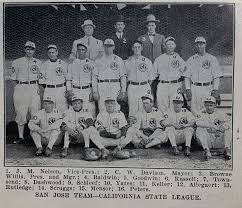An Overview of the Oakland Oaks
- David Hegler

- Sep 17, 2020
- 3 min read
Updated: Oct 12, 2020

Before the A’s came to Oakland in 1968, the Oakland Oaks were the city’s baseball franchise. Occupying the historic Pacific Coast League, the Oaks won championships and featured a number of future World Series winners including Casey Stengel and Billy Martin. The influence of it’s alumni have greatly affected baseball today. What follows is an overview of the history of the Oakland Oaks.
The Beginning
The Oakland Oaks were a founding member of the Pacific Coast League (PCL) in 1903. The PCL would quickly grow into one of the premier regional baseball leagues in the nation and the Oaks success was a key ingredient to the PCL’s legacy. The Oaks became champions in 1912 with a 120-83 record but were without a stadium of their own until the following year. At a cost of just $80,000, the new stadium occupied the old homestead of land developer Joseph Emery, Emeryville’s namesake, on the corner of Park Avenue and San Pablo Avenue. It was quite a site, with bars, casinos and theatres as the ballpark’s neighbors. Although the ballpark resided in Emeryville, the team elected to name it “The Oakland Oaks Baseball Park”.

Jackie Robinson is known as the first to break the color line in the MLB but few know that the Oaks actually preceded that achievement back in 1916, a full 31 years before Robinson. Jimmy Claxton was a Canadian-born left handed pitcher who convinced the Oaks that he was Native American. He was only with the organization for a month when a teammate found out that he was of both African American and Native American ancestry. That teammate then betrayed him, telling the team that he was part African American and Claxton was cut from the team. It was a shameful smudge on a proud franchise.
The team struggled during World War I and only had a couple of winning seasons since its first championship. Their fortunes changed in 1927 when they won the PCL championship with a 120-75 record. While they didn’t win the league championship every year, the Oaks produced enough talent to catch the eye of the New York Yankees. From 1935 to 1937, before the advent of the modern farm system, the Oakland Oaks were an affiliate of the New York Yankees. It was the start of a long, prosperous relationship between the Yankees and the city of Oakland. Years later, in order to save money from expensive contracts, the Oakland A’s would send many of their best players to the Yankees.
The Glory Years

Following World War II the club owners set out to build a dominant team. Their 1946 squad included Billy Martin, Catfish Metkovich, Cookie Lavagetto, Ernie Lombardi and Nick Etten. However, that particular team did not win the championship but it did post a 111-72 record. Their fortunes changed in 1948 when future Yankee manager Casey Stengel led the Oaks to the PCL championship with a 114-74 record. Stengel left for the Yankees following the season and the Oaks had trouble adjusting for a year. Stengel would go on to lead the Yankees through their greatest decade, winning seven World Series, and he would be voted into the Baseball Hall of Fame in 1966. The Oaks won the championship without Stengel in 1950 with a 112-82 record.
The Demise and Relocation
The demise of the Oakland Oaks happened quickly and seamlessly. Following their last PCL championship in 1950 the team started to lose games at a furious rate. By 1955, the team finished eighth in the PCL and it’s attendance was a fraction of what it once was. After the season, the owners decided to move the team to Vancouver, British Columbia where it was renamed the Mounties. In 14 years in Vancouver, the team never finished better than second place in the PCL. Their attendance fluctuated with the good and bad seasons. During their time in Vancouver, they were affiliated with the Minnesota Twins. They were displaced by the Dallas-Fort Worth Rangers which joined the PCL in 1963 and inherited the Mounties’ roster and Twins affiliation. The A’s don’t have a tribute to the Oaks such as a mascot, like the Giant’s mascot Lou Seal, but the memory of the Oak’s legendary players lives on in the annals of the early days of baseball in the East Bay.



Comments